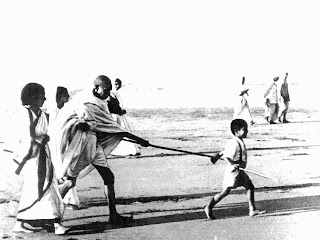(the Sandarbh Nature Art Workshop 2010 Participants with Somu Desai)
(Looking for appropriate sites to start the site specific works)
At Luhari forest resort in Silvassa, Dadra and Nagar Haveli, UT, a set of young artists are seen charged with a new experience. They are here for Sandarbh Nature Workshop, this year held away from its regular platform at Partapur in Rajasthan. The artists have come from different parts of India, most of them participating in such a workshop for the first time in their creative life. The age group ranges from 21 to 46 and if anybody asks for gender balance, yes here they are, nine women artists and seven male artists. And many more volunteers. This time artist Somu Desai has taken the helm at his hands. Silvaasa is his home turf and he plays it well here.
(Mrugdha Joshi, Somu Desai, Paribartana Mohanty and JohnyML at the Luhari Forest Resort)
Silvaasa is strip of land with saal and teak forests. From the city centre, where the houses of administration are located, drive around ten kilometers towards south you reach Luhari, the village where the forest resort is located. Around it there is a thick reserve forest fenced all the way to protect the villages scattered around, from the attack of wild animals. These are backward villages with one primary school and one health care centre. The villagers till the land and do some agriculture. Most of them subsist on the forest produce.
(Art Critic Abhijit Tamhane addressing the workshop members at Luhari)
Though, the Luhari forest resort is a ‘resort’ by name, people from the villages around come in the campus quite often to collect twigs and fallen wood. Lovers from the city once in a while come here to have some private moments. During the weekends, families from the nearby town come here to do picnic. There is a rock bed, lawn and garden, and there are six cottages, a dormitory and a kitchen. The cottages are raised on false tree shapes to give the impression of tree houses. The lower level of the cottages is used as shelters by picnic teams.
(At Luhari Leopard Sanctury)
Sandarbh Nature Workshop started here on 20th November 2010. During the day time artists trek the interiors of the villages and find locations for their works. Some of them have already started their works. Some have already finished their site specific works and yet another group is on their way to do newer works in newer sites.
During evenings, the artists congregate under the cottages and do slide presentations. A few artists are contemplating performances. Art critic and writer Abhijit Tamhane had visited the workshop in one of the initial days. Not only had he initiated a dialogue on public performance and public art but also he has done one site specific work; I would read it as an act for collapsing the hierarchical structure within the public art creations in our country.
(A slide presentation is on at night)
I am here today. My idea is to write about the works, interview the artists and generate a fruitful dialogue on site specific art and the role of public art in the discourse of ‘public/art’.
(A Trip to Dudhni)
I will be posting detailed writings on individual artists, their works and the dialogue that they have generated through their works in the coming few days. Watch out my blog for updates on Sandarbh.


















































